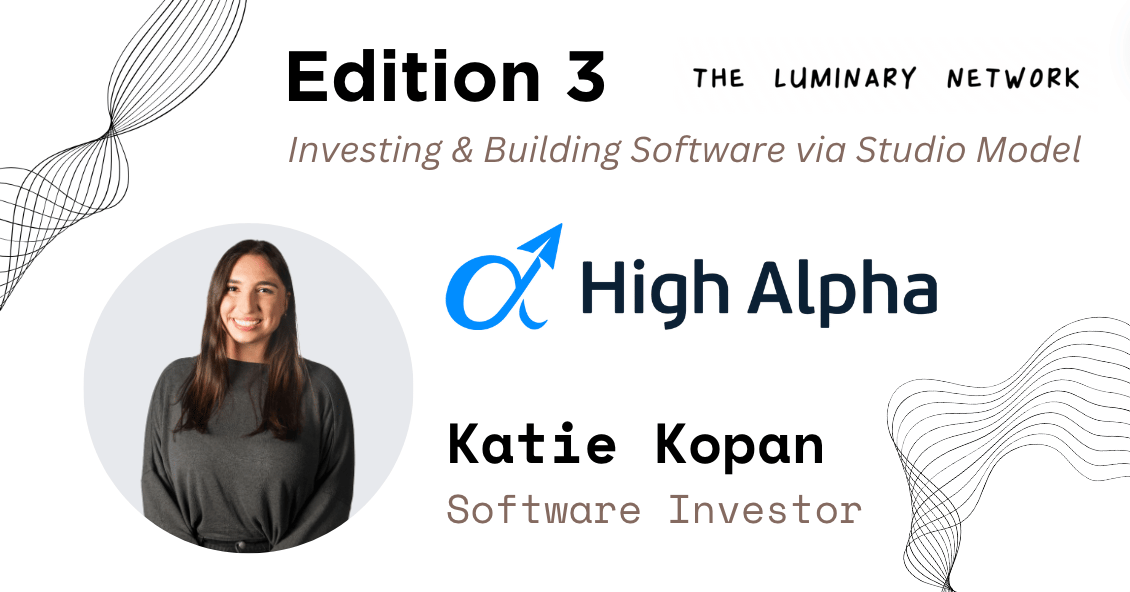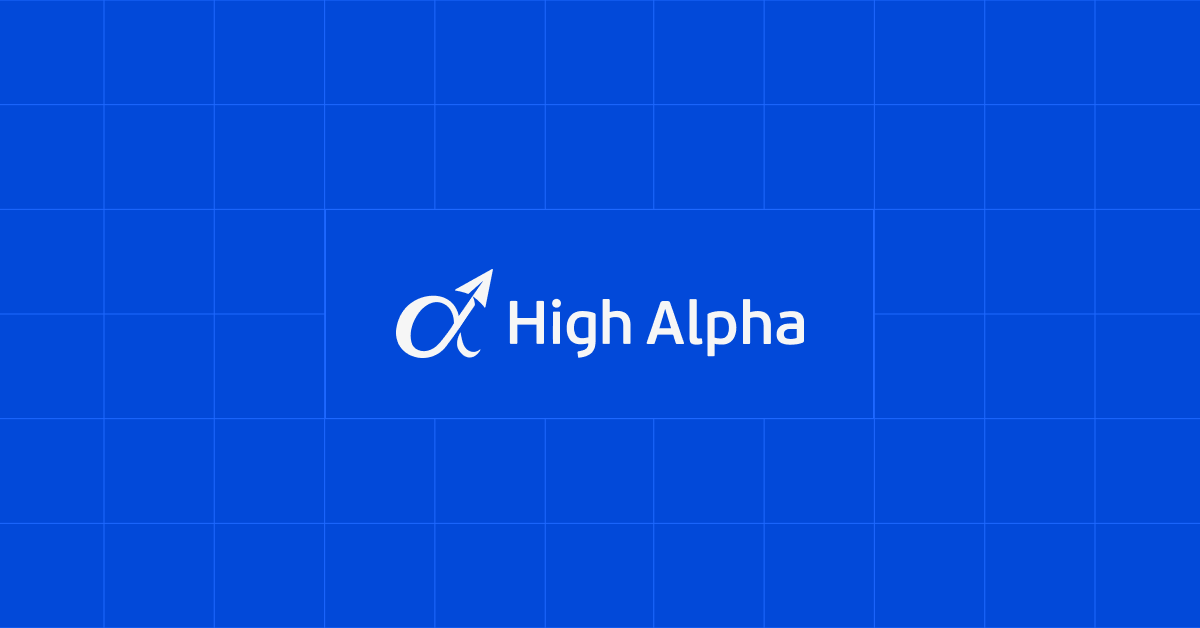- The Luminary Network
- Posts
- Investing & Scaling Early Stage B2B SaaS at High Alpha
Investing & Scaling Early Stage B2B SaaS at High Alpha
Leveraging the venture studio to build outstanding companies

Venture Studio [def]:
An organization that co-creates multiple startups simultaneously alongside founding teams and industry partners, using its expertise, shared resources, and infrastructure to “turn ideas into investable opportunities and scalable businesses.” (High Alpha).
In this issue, we’ll explore the venture studio model, and how it has produced companies like Moderna, Snowflake, and Dollar Shave Club. I’m fortunate to have had the opportunity to chat with Katie Kopan, to learn about her experience backing and building outstanding B2B SaaS companies, through High Alpha’s venture studio.
Today’s schedule 👇
Not subscribed to The Luminary Network? Sign up below to gain direct perspective from the boldest founders, operators, and investors in tech & innovation!
Overview: Origins of the Venture Studio Model
A venture studio is an organization, often led by expert, serial entrepreneurs, that co-develops and scales businesses alongside founders and industry partners. They provide in-house resources such as marketing and go-to-market services, finance and accounting, and product + brand design, to position the company for success when establishing product-market fit, and eventually, through its growth stages.
The venture studio model got its roots in 1996, when Bill Gross founded IdeaLab. Since its inception, the incubator has founded over 150 companies, and achieved 45 exits. Notable exits include Overture (now GoTo.com), an online advertising platform that was acquired by Yahoo! for $1.63 billion in 2003, and is often credited with developing the model that powers Google AdWords (source). Additionally, Picasa was acquired by Google in 2004, and is now modern-day Google Photos.
Gross, having started IdeaLab during the dot-com bubble, saw the massive opportunity for new businesses that the internet presented, and developed the venture studio model to build technology businesses that would capitalize on the novel capabilities that the internet would ultimately provide.
Additionally, over the course of its 30-year tenure and the 5,000+ business ideas that its tested, IdeaLab has scaled 150 commercially viable businesses (3% success rate), and 70% of which have been successful in the market (source). Of course, a 3% success rate may seem modest on the surface, but when compared with traditional rates of venture-backed startups at the seed stage, IdeaLab was over twice as successful in building businesses that would eventually become successful in the market - but, why is this the case?
How a Venture Studio Yields Successful Outcomes
When it’s boiled down, there are a few key drivers that contribute to why the studio model has proven to be effective in developing and scaling new businesses, across all industries. Two of which include:
Reason #1: Direct Access to Expert-Level Advisory from Idea Exploration to Scale
The majority of venture studios are led by serial entrepreneurs, who have already established a track record of validating, building, and scaling startup companies. In the studio model, their objective is to provide founders with advisory around every facet of company creation, from idea validation, product development, brand design, establishing product-market fit, and scaling the company via marketing and sales motions (to name a few).
Because studios have this expertise in-house, founders are supported each step of the way, starkly contrasted from the experience of a founding team going it alone.
Reason #2: De-risked Company Selections through Market Validation
When a studio has a fledgling idea for a company, often the first step is to conduct an exploration phase. This consists of deep research of relevant markets, trends, and customer segments (includes in-depth interviews with customers and industry experts). This is done for a few reasons, including but not limited to:
Precisely understand whether the market(s) the concept business is targeting are large enough
Determine if the identified problem is profound enough, from the perspective of consumers - to the point they’d actually pay for the ideated product / service
Evaluate the competitive landscape, based on the fragmentation of the space, growth rate and drivers of the market, and similarity + differences between incumbents’ products
Intention is to determine whether there is a large enough opportunity for the company to gain market share based on its differentiation
Once the studio has completed the exploration phase, they essentially have vetted each of the initial ideas they have for potential businesses. Now that it has been more informed on the commercial viability of each idea, they can choose the ones that have the most upside, and have the best alignment with the studio’s unique expertise.
High Alpha Brings Venture Fund to Studio
Now that the stage has been set for how the venture studio came to be and a few key reasons why it produces commercially successful companies at a higher rate than other avenues, let’s dive into High Alpha, specifically.

A B2B SaaS Venture Fund & Studio, based in Indianapolis, Indiana
Just four years after Bill Gross founded IdeaLab, Scott Dorsey, Chris Baggott, and Peter McCormick founded ExactTarget, a revolutionary cloud marketing solution. In 2013, the company was sold to Salesforce for $2.5 billion (now known as Salesforce Marketing Cloud).
Mike Fitzgerald, Eric Tobias, and Kristian Anderson were also key employees at ExactTarget, and it was here that Scott Dorsey had come to know them. The four sought to revolutionize how businesses were built and invested in, while pouring back into the Indianapolis technology ecosystem. In April 2015, they co-founded High Alpha to do just that.
High Alpha’s Approach to Building Software Companies
The firm, founded nearly a decade ago in 2015, focuses in B2B SaaS, as the founding partners’ expertise was in software. They invest in early stage enterprise software companies from coast-to-coast, and secured a $125M Fund IV just a few weeks ago (June 2024).
Since its inception, the firm has operated in two separate, yet overlapping areas: the studio, and the venture fund. With Fund IV, the team is seeking to more closely interweave these two functions. The belief, is that their work as investors make them stronger operators, and vice versa.
Their studio framework consists of three stages:
Stage #1: Explore
Above, we discussed the exploration phase. The same applies here. The intention, is to A) develop the idea, then validating it in the marketplace through secondary and primary research, and initial prototyping. Additionally, a business plan and pitch deck is developed based on this initial research
Once the Explore phase is complete, High Alpha will determine which ideas have the most upside in the marketplace and offer the best fit with the unique expertise of their team, and move forward with a select few.
Stage #2: Build
This is where the firm’s core areas of expertise come into play - It’s now time for the core pillars of the company to take shape. High Alpha possesses subject matter experts across each of the six areas below.
For example, a team of brand designers works diligently to craft a brand that strategically differentiates the company in the marketplace. “We provide an unfair advantage in helping founders think through how they’re showing up in the marketplace in every customer experience” - Jon Hubartt, VP of Design & Product.
A separate in-house service that the studio provides to companies, is talent sourcing. As the company develops, the exceptional network of the partners and management team enable High Alpha’s HR function to supply best-fit talent for each company from inception, all the way through exit.
From talking to Katie, as well as from my own review of High Alpha, it seems that a key point of differentiation is their ability to establish product-market fit. Leveraging, again, the vast network of industry experts and potential customers that management has access to, the studio is able to seamlessly connect founding teams with the right contacts at scale. This enables studio companies to rapidly iterate their offering based on consumer and expert insight, to accelerate time to product-market fit.
Stage #3: Scale
Drawing back on Scott Dorsey and team’s $2.5B sale of ExactTarget, they got there by growing the business - this is the benefit of working side-by-side with serial entrepreneurs, as they have already been there, done that. This comes in handy when companies reach the point at which they are looking to move beyond initial customer contracts - to either build relationships with new customers, renew initial contracts to secure second ones with higher dollar amounts, and/or expand the number of offerings the company can offer to customers.
Investing at High Alpha: Insights from Katie Kopan
Background on Katie’s Journey into Venture
At Miami University, Katie was a Finance and Entrepreneurship co-major, and helped co-found Advancing Women in Entrepreneurship, and Social Impact Fund.
First formal venture experience was an internship at CincyTech, an early-stage software and life sciences firm in Cincinnati, Ohio. She got to work closely with founders and funders helping with diligence and supporting existing portfolio companies. This is where she learned her affinity for investing in software.
Going into the first semester of her Senior year, Katie used her network at CincyTech to secure an internship with a Series A health tech portfolio company, to see how her interest for operator work compared with the investing side.
This was a deeply valuable experience, but she missed the investing side of the table
Secured an internship second semester of Senior year with Allos Ventures, where she got to spearhead investment work on a ton of deals → solidified Katie’s interest in pursuing VC post-grad
Katie utilized her network to source an opportunity at High Alpha → the timing aligned well!
Now, let’s get into some Q & A
Q: What is a high-level overview of your role?
There are three main areas I focus on
Sourcing and running diligence on deals. This is a mix
of deals I found as well as within our team’s network.
Supporting portfolio companies. This includes quarterly
financial reporting, helping with pitch decks and fundraising conversations, and any ad
hoc projects they may need help with.
Back office support. This includes post-investment
workflows, quarterly reporting for our investors, and optimizing our internal tech stack.
Q: Does High Alpha only invest in the companies it develops through the studio, or does it source externally as well?
Historically High Alpha has invested 50/50 in studio and external companies. As we start deploying Fund IV, we’re placing a greater emphasis on leading external financings from coast-to-coast and targeting 3-5 new companies as we refine our focus and resources.
Q: What traction profile do you look in potential investment targets?
We prefer to lead investments in B2B SaaS companies selling annual and multi-year contracts with enterprise buyers. Generally, these businesses have $500k-$3M ARR and less than $10M in funding. Our ideal round size is $6-$8M, where High Alpha can invest $3-6M and obtain a board seat.
Q: What do you look for in founding teams to determine if they are the team to solve the given problem and take it all the way?
Subject matter experts with a differentiated point of view
Ability to be assertive and close deals
Can hire and retain quality talent from the early days through scale
Refer a Friend 🤝🏻
Click the button below to refer a friend if you liked today’s content!
Connect 👋
A TREMENDOUS thank you to Katie for sharing her journey into venture and an insider perspective on the studio model! Connect with her on LinkedIn!
Also, feel free to connect with me on LinkedIn, or via email at [email protected]. I appreciate any and all feedback!
Lots of exciting plans in the works. 🚀
-Jack
